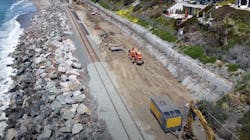All trains to return to tracks in Orange and San Diego counties following slope stabilization
Full passenger rail service will return to tracks south of San Clemente, Calif., starting April 17, following successful emergency repairs by Orange County Transportation Authority (OCTA) to stop slope movement and stabilize the tracks.
Metrolink and Amtrak trains halted movement through the corridor “out of an abundance of caution” following a storm surge in September 2022 that caused the slope adjacent to the tracks to move. A similar event occurred in September 2021. OCTA reported the movement in September 2022 was being measured at .01 inches to 0.4 inches per day. OCTA owns 40 miles of track in Orange County, including the seven miles along the coast where the slope issue occurred.
OCTA and its contractor, Condon-Johnson & Associations Inc., installed tiebacks and ground anchors to halt the slope movement, which will allow full rail service to resume.
“This emergency work has posed an unprecedented challenge, especially with the heavy rainfall this season, and we’re pleased to announce passenger service can safely resume on this key stretch of southern California rail,” said OCTA Chairman and Mayor of Yorba Linda Gene Hernandez. “We greatly appreciate the public’s patience and their understanding that ensuring passenger safety is always the first priority.”
Amtrak Pacific Surfliner weekend service resumed in February after the installation of the first row of ground anchors were installed. With full passenger rail service returning for both Amtrak and Metrolink, a bus bridge connecting Oceanside and Irvine will no longer be needed.
“The reopening of the tracks in San Clemente restores vital intercity rail connections between San Diego, Los Angeles, Santa Barbara and San Luis Obispo,” said Jason Jewell, managing director of the LOSSAN Agency, which manages Amtrak Pacific Surfliner service. “We thank our customers for their patience during this extended construction period and look forward to welcoming them back next week.”
Anchors, tiebacks and inclinometers
Two storm surge events 13 months apart – one in September 2021 and another in September 2022 – coupled with sand erosion on one side of the tracks and a gradually sliding hillside on the other moved the track by as much as 28 inches.
OCTA, which said it found itself in “uncharted territory,” approved emergency repairs in October 2022 with work beginning shortly after. The $13.7 million project is funded in part by $6 million in emergency funding from the California Transportation Commission and a $6 million Surface Transportation Block Grant.
More than 200 ground anchors, each 130-feet long, were drilled into the bedrock along a 700-foot stretch of track to halt movement of the slope and stabilize the track. OCTA reported to its crews will finish this week the installation and locking off the second row of grade beam panels and ground anchor tiebacks that are stabilizing the privately-owned hillside next to the track this week
Installation on the first row of tiebacks and ground anchors was finished earlier this year, with the second row added for additional stabilization. However, OCTA reports inclinometers have not shown movement of the hillside or track since the first row was completed. Site conditions continue to be monitored to ensure safety.
The final steps of the emergency project include covering the retaining wall and replanting native vegetation.
Long-term fix planned
OCTA will pursue a two-phase approach to further study and understand the issues behind the coastal erosion that prompted the emergency repairs. The studies, which are estimated to cost $7 million, will explore solutions, including potentially moving the rail line, with a goal of continuing safe passenger rail service.
OCTA issued a Request for Proposals for a two-year Phase 1 study, which is estimated to cost $2 million and will be covered by a grant. The Phase 1 study will engage stakeholders and agencies as it develops strategies to safeguard coastal rail infrastructure, aims to understand the impact climate change may have on the rail line and identifies solutions to combat beach erosion.
A Phase 2 study would see greater collaboration with LOSSAN Agency, as well as state and federal agencies. The study would develop options to protect or relocate the rail line and create an action plan.
The estimated cost of the Phase 2 study is $5 million, and OCTA has not identified any funds to cover the study. However, should funding be secured, OCTA says both phases of the study could be conducted simultaneously.
About the Author

Mischa Wanek-Libman
Group Editorial Director
Mischa Wanek-Libman is director of communications with Transdev North America. She has more than 20 years of experience working in the transportation industry covering construction projects, engineering challenges, transit and rail operations and best practices.
Wanek-Libman has held top editorial positions at freight rail and public transportation business-to-business publications including as editor-in-chief and editorial director of Mass Transit from 2018-2024. She has been recognized for editorial excellence through her individual work, as well as for collaborative content.
She is an active member of the American Public Transportation Association's Marketing and Communications Committee and served 14 years as a Board Observer on the National Railroad Construction and Maintenance Association (NRC) Board of Directors.
She is a graduate of Drake University in Des Moines, Iowa, where she earned a Bachelor of Arts degree in Journalism and Mass Communication.
